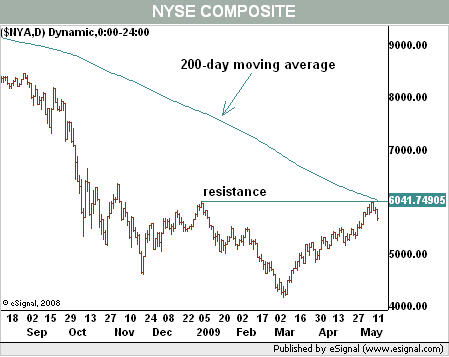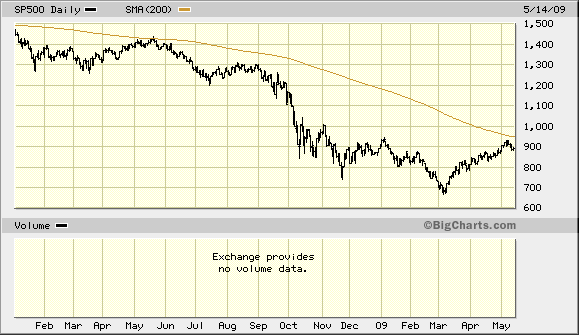200 DMA Is Big Resistance
The New York Stock Exchange composite index was stopped last week at resistance just north of the 6000 level and just south of its 200-day moving average. This is the first time in one year that the latter has been close to the trading action and that gave traders a psychological motivation to sell.
– Michael Kahn, “The Bear Puts On Some Weight” (subscription required), Barron’s, May 13

I was reading Michael Kahn’s most recent Getting Technical article last night in which he pointed out that the major indexes were in the range of their 200 day moving averages for the first time in about a year. I hadn’t realized we’d gotten so close. It’s important because the 200 DMA should be major resistance.
That’s because when an index is trading above its 200 DMA, a long term trendline, many technicians and investors consider it to be in a bull market. When it is trading below it, they consider the index to be in a bear market. Taking it even further, many use this simple long term trendline as a strong guideline as far as whether to be in the market or out of it.
As one prominent example, well known investment advisor Roger Nusbaum, author of Random Roger’s Big Picture, frequently talks about his heavy reliance on the 200 DMA:
Another aspect of this is taking defensive action based on an objective measure, for me the 200 DMA. By using an objective trigger point it removes the need to be right or the consequence of being wrong about what you think will happen. For me, when the market goes below its 200 DMA I begin defensive action. When it goes back above I begin re-equitizing.
– Roger Nusbaum, “Feliz Cinco de Mayo”, May 5
For now demand for equities in unhealthy. I want to remain somewhat defensive until demand again gets healthy. I define “healthy” as the S&P 500 being above its 200 day moving average.
– Roger Nusbaum, “Interview In The Local Gazette”, April 7
Another example of an investor who relies heavily on the 200 DMA is frequent Fast Money commentator Dan Fitzparick (Click here for two recent examples).
That means that many investors watch how the index behaves around this trendline and will be quick to sell a failure at that level or buy a breakout. A failure would convince many that this is still a bear market and result in selling.
Note the failure of last year’s Mar-May bear market rally right around the 200 DMA.

